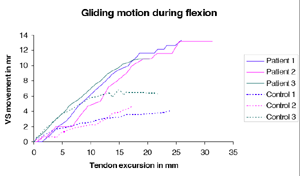Flexor Tendon and Subsynovial Connective Tissue Gliding in Carpal Tunnel Syndrome

Figure 1: The motion of the FDS III tendon and visceral synovium in 3 patients and 3 cadaver controls
Principal Investigator: Peter C. Amadio, M.D.
Project Coordinator: Chunfeng Zhao, M.D. — zhao.chunfeng@mayo.edu
The characteristic pathological finding in carpal tunnel syndrome (CTS) is non-inflammatory fibrosis of the synovium. We believe that the relative motion between the flexor tendon and the visceral synovium is an important index of the behavior of the subsynovial connective tissue (SSCT). If the stiffness of the SSCT is increased in CTS, it is likely that the gliding characteristics will be affected. To investigate this possibility, the relative motion of the flexor tendon and visceral synovium was observed in 3 patients undergoing carpal tunnel release and compared these with simulated active flexion in 3 cadaver controls. Our results show that during movement of the FDS III tendon, the SSCT and visceral synovium are moving with the tendon (Fig. 11). In patients with carpal tunnel syndrome, the SSCT is moving en bloc with the tendon, whereas, in the control tissue the SSCT moves smoothly and separately from the tendon, as a sleeve moves separately from the arm within it.
These findings suggest that in patients with CTS the fibrosis of the SSCT has altered the gliding characteristics of the tendons, which may affect their ability to effectively and efficiently transmit load to the fingers, or to glide independently from each other, or from the nearby median nerve.